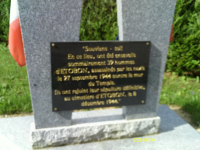More Witnesses
 A marker commemorates the site of the mass grave at Chenebier
A marker commemorates the site of the mass grave at Chenebier
There were at least three other witnesses who provided accounts of the murder of 39 men against the church wall in Chenebier. In addition, residents of Chenebier told how the Germans forced them to dig a mass grave and bury their neighbors from Etobon. Some said their sabots (wooden shoes worn by farmers and gardeners) were filled with blood at the end of this ordeal.
Recently, a marker has been placed in the Chenebier cemetery to commemorate the location of the mass grave. The martyrs of Etobon are now buried in their own cemetery in their native village. The marker is located behind the Lutheran church, to the right at the entrance to the cemeter. It is next to Daya Ram's grave, one of the Indian prisoners who died in Chenebier. The Chenebier cemetery is also commemorated as an official Commonwealth Graves Site because of Ram's presence there.
Here are eyewitness reports from Chenebier:
Statement of Mayor Henisse:
“I did not take part in the executions. After the crime, I had to get a dozen men together to dig a mass grave in the cemetery, very close to the church. The victims were laid down on straw in three rows, each on top of the last. The third row was not complete. During the burial, the Italian who had been the executioner did not stop singing and whistling, with a kind of satanic joy. In the days following this drama, the Germans billeted in the village forbid anyone from entering the cemetery and forbid anyone to leave flowers.”
Statement of M. Paul Lods, innkeeper at Chenebier:
“The soldier of the German army who was the executioner, September 27, 1944, belonged to a Cossack cavalry unit stationed in the village. This man was staying in my house. He volunteered and showed great joy at taking part in the execution. We had his military papers in our hands. He is an Italian citizen, Pietro Pilot, from Sicily, born June 29, 1924.”
 The Abry home, across the street from the site of the massacreStatement of Mme. Emmanuel Abry
The Abry home, across the street from the site of the massacreStatement of Mme. Emmanuel Abry
“The 67 men of Etobon, who arrived about 12:30, were locked up in the old sewing workshop next to my house. My youngest daughter and I tried to listen to what was happening all afternoon, without being able to make sense of anything, except a few names … A little after 4:00, the first group of ten men were taken to the side of the church. The victims were forced to kneel, facing the firing squad. The next two groups were also killed while kneeling, but turned away from their executioners. The fourth group died standing, facing the firing squad, singing “La Marseillaise.” My husband and our neighbor Paul Roy watched the executions from the windows. Both of them were then deported to Germany.” [editor's note: I officiated at Paul Roy's funeral. He returned home on foot from Germany when the war ended and lived into his 80s.]
 Katherine Douglass
Katherine Douglass
Reader Comments